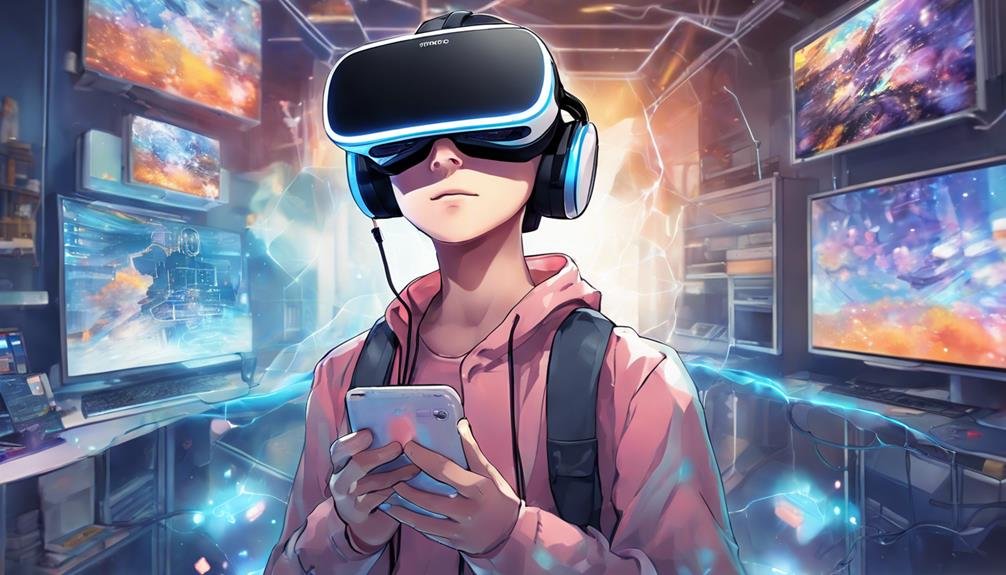What Are the Emerging Technologies Shaping the Future of E-Learning?
Discover how virtual reality, artificial intelligence, gamification, and adaptive learning systems are transforming e-learning. Immerse yourself in VR for realistic scenarios and enhanced engagement. AI personalizes learning with tailored experiences and feedback. Gamification boosts motivation through interactive elements and challenges. Adaptive systems cater to individual needs, offering personalized paths for continuous improvement. These technologies create dynamic, engaging, and interactive educational experiences. Explore further for insights into the exciting future of e-learning.
Key Takeaways
- Virtual reality and augmented reality for immersive learning experiences.
- Artificial intelligence personalizes learning and provides real-time feedback.
- Gamification enhances engagement and motivation in online learning.
- Internet of Things for interactive learning environments.
- Adaptive learning systems tailor educational content to individual student needs.
Artificial Intelligence in E-Learning
Explore how artificial intelligence revolutionizes the landscape of e-learning by personalizing learning experiences and enhancing student engagement. AI-driven assessments and adaptive tutoring algorithms are at the forefront of this transformation. Imagine a learning environment where assessments aren't just tests but tailored experiences that adapt to your strengths and weaknesses in real-time. These AI-driven assessments analyze your performance instantly, providing targeted feedback and personalized learning paths to help you improve continuously.
With adaptive tutoring algorithms, e-learning becomes more interactive and dynamic. These algorithms adjust the content and pace of learning based on your individual progress and learning style. Gone are the days of one-size-fits-all instruction. Now, you can receive customized lessons that cater to your specific needs, ensuring a more effective and engaging learning experience.
Incorporating AI into e-learning not only streamlines the learning process but also makes it more effective and enjoyable. Embrace the future of education where artificial intelligence works tirelessly behind the scenes to enhance your learning journey.
Virtual Reality Integration
Get ready to explore the future of e-learning with Virtual Reality Integration.
Imagine immersing yourself in realistic scenarios, engaging with interactive simulations, and moving through 3D virtual environments.
These advancements are revolutionizing the way you learn, making education more dynamic and engaging than ever before.
Immersive Learning Experiences
Immerse yourself in a new era of learning as virtual reality integration revolutionizes educational experiences.
Immersive simulations transport you to realistic scenarios, allowing for hands-on learning in a safe environment.
Virtual classrooms enable interaction with instructors and peers from anywhere, fostering collaboration and engagement.
Through immersive learning experiences, complex concepts become tangible, enhancing understanding and retention.
Imagine practicing surgical procedures without risk, exploring historical events firsthand, or conducting virtual science experiments.
The possibilities are endless as virtual reality breaks down traditional learning barriers.
Embrace this cutting-edge technology to access a new dimension of education, where learning isn't just observed but experienced.
Get ready to delve into a world where knowledge comes alive through immersive learning experiences.
Interactive Simulations
Begin a dynamic educational journey through the integration of interactive simulations, particularly virtual reality technology, enhancing your learning experience like never before.
- Simulation effectiveness: Experience the power of realistic simulations that mimic real-world scenarios, allowing for practical application of knowledge.
- User engagement: Stay actively involved in the learning process through immersive experiences that capture your attention and foster deeper understanding.
- Interactive feedback: Receive instant feedback on your actions within the simulation, enabling you to learn from mistakes and make improvements in real-time.
- Scenario-based learning: Engage in hands-on learning by exploring different scenarios, enhancing critical thinking and problem-solving skills in a safe virtual environment.
Explore the endless possibilities of interactive simulations in e-learning, where learning becomes an engaging adventure.
3D Virtual Environments
Enter a fascinating adventure into the world of Virtual Environments, where the incorporation of virtual reality technology transforms the landscape of e-learning. In a virtual classroom, learners can engage with interactive 3D environments, enhancing their educational experience through immersive training sessions.
These environments allow for realistic scenarios, simulations, and hands-on activities that simulate real-world experiences, providing a dynamic and engaging way to learn. Through virtual reality integration, learners can interact with the content actively, boosting retention and understanding.
The virtual classroom setting enables educators to create personalized learning experiences tailored to individual needs, fostering a more effective and efficient learning process. Embrace the future of e-learning through Virtual Environments, where innovative technology revolutionizes the way we acquire knowledge.
Adaptive Learning Systems
Ready to explore Adaptive Learning Systems?
Get ready for a learning experience tailored just for you.
Personalized Learning Paths, Data-Driven Instructional Design, and Real-Time Student Feedback await!
Personalized Learning Paths
Experience the power of personalized learning paths through adaptive learning systems to tailor educational experiences to your individual needs and preferences. These systems use AI-driven recommendations and personalized assessments to create adaptive pathways that enhance student engagement.
Here are four key benefits of personalized learning paths:
- Customized Learning: Receive content tailored to your specific knowledge gaps and learning pace.
- Immediate Feedback: Get instant feedback on your progress to address misconceptions promptly.
- Enhanced Motivation: Stay engaged with interactive content that adapts to your interests and learning style.
- Improved Retention: Increase retention rates by focusing on areas that need reinforcement.
Personalized learning paths provide a more effective and engaging learning experience tailored just for you.
Data-Driven Instructional Design
Utilizing data-driven instructional design, adaptive learning systems dynamically adjust educational content based on individual performance and engagement metrics. By analyzing learner analytics, these systems can tailor the learning experience to meet the specific needs of each student.
Through data-driven assessment, educators gain valuable insights into how learners are progressing, allowing for targeted interventions and personalized feedback. This approach enhances the effectiveness of instruction by providing real-time feedback and adapting the content to optimize learning outcomes.
With adaptive learning systems, students receive a customized learning path that suits their unique learning styles and pace, fostering a more engaging and efficient educational experience. Data-driven instructional design empowers educators to make informed decisions that positively impact student learning.
Real-Time Student Feedback
Real-time student feedback plays an essential role in adaptive learning systems by providing immediate insights into individual student progress and engagement levels. This feedback loop allows for real-time assessment, enabling educators to make timely interventions to enhance learning outcomes.
Here are four key points to ponder:
- Enhancing Student Engagement: Instant feedback keeps students actively involved in their learning process.
- Personalized Learning Paths: Real-time feedback helps tailor learning experiences to individual needs.
- Improving Learning Outcomes: Immediate insights enable educators to adjust teaching strategies for better results.
- Continuous Monitoring: Feedback loops allow for ongoing monitoring of student progress, ensuring timely support when needed.
Mobile Learning Applications
Mobile learning applications have revolutionized the way people access educational content on-the-go. These apps offer offline accessibility, allowing you to continue learning even without an internet connection. Imagine being able to study during your commute or in remote areas without worrying about connectivity issues. Additionally, mobile learning applications often feature interactive quizzes that help reinforce your understanding of the material in a fun and engaging way.
Another key feature of these apps is the use of microlearning modules, which break down complex topics into bite-sized chunks. This approach makes learning more manageable and helps you retain information more effectively. Furthermore, many mobile learning platforms promote social collaboration, enabling you to connect with peers, instructors, or experts in the field. By engaging in discussions, sharing insights, and receiving feedback, you can enhance your learning experience and gain valuable perspectives.
Gamification Techniques
Ever thought about learning through games?
Engage in learning experiences that feel more like fun than work, track your progress with incentivized rewards, and interact with game elements that make education exciting.
Get ready to level up your learning with gamification techniques!
Engaging Learning Experiences
To enhance engagement in e-learning, incorporating gamification techniques can transform traditional learning experiences into interactive and dynamic journeys for learners. By infusing elements of games into educational content, you can create a more immersive and enjoyable learning environment.
Here are some ways gamification techniques enhance engagement:
- Points and Leaderboards: Encouraging healthy competition among learners.
- Badges and Achievements: Rewarding progress and accomplishments.
- Interactive Quizzes: Making assessments more engaging and fun.
- Storytelling: Creating narratives that draw learners into the content.
These strategies not only make learning more enjoyable but also foster collaborative projects and experiential learning, enhancing the overall educational experience.
Incentivizing Progress Tracking
Encourage learners to track their progress through interactive methods such as progress bars and milestone achievements, fostering motivation and engagement in the e-learning journey. By incorporating gamification incentives and progress tracking rewards, you can create a sense of accomplishment and drive to reach the next level.
Data-driven motivation allows for personalized feedback incentives, guiding learners on areas needing improvement and celebrating their successes. Progress tracking rewards, like badges for completing modules or accessing special content, can make the learning experience more interactive and enjoyable.
These gamification techniques not only make tracking progress fun but also inspire continuous learning and engagement throughout the e-learning process.
Interactive Game Elements
Explore how interactive game elements, also known as gamification techniques, can transform the e-learning experience by enhancing engagement and motivation levels for learners. Incorporating interactive storytelling immerses learners in the educational content, making the learning process more enjoyable and memorable.
Game-based assessments provide a fun and interactive way for learners to test their knowledge and skills. Digital badges serve as rewards for completing tasks or mastering specific topics, motivating learners to aim for progress.
Skill-building challenges offer opportunities for learners to apply knowledge in practical scenarios, reinforcing their understanding and retention. By integrating these gamification techniques, e-learning platforms can create a dynamic and engaging environment that encourages active participation and continuous learning.
Augmented Reality Tools
Amid the ever-evolving landscape of e-learning, incorporating augmented reality tools has become a game-changer in enhancing user engagement and interactivity. AR learning applications offer spatial learning experiences that bring a new dimension to traditional online education. Imagine exploring the human anatomy up close or dissecting virtual frogs in a biology class – all made possible through interactive AR modules. These tools not only make learning more immersive but also cater to different learning styles.
Furthermore, the integration of augmented reality into e-learning has paved the way for gamified learning environments. By merging educational content with interactive gameplay elements, students are motivated to actively participate in their learning journey. Whether it's solving puzzles to access new lessons or earning rewards for completing tasks, gamified AR experiences make the educational process more enjoyable and effective.
Big Data Analytics
Integrating big data analytics into e-learning opens up new possibilities for personalized learning experiences tailored to individual student needs and preferences. By utilizing predictive analytics, educators can anticipate student behavior and performance, enhancing student engagement and motivation.
Learning analytics offer insights into how students interact with course materials, enabling instructors to make data-driven decisions to improve learning outcomes. This data-driven approach allows for the identification of at-risk students early on, providing timely interventions to support their success.
Additionally, big data analytics can lead to continuous performance improvement by tracking student progress and adapting learning paths accordingly.
- Predictive Analytics: Anticipate student behavior and performance.
- Student Engagement: Enhance motivation through personalized learning experiences.
- Learning Analytics: Provide insights into student interactions with course materials.
- Performance Improvement: Track progress and adapt learning paths for better outcomes.
Personalized Learning Platforms
Personalized learning platforms revolutionize the educational experience by tailoring instruction to individual student needs and preferences. Through sophisticated student assessment techniques, these platforms gather data on each learner's strengths, weaknesses, and learning styles. By analyzing this data, the platform can then dynamically adjust the content and pace of instruction to suit the student's specific requirements, ensuring a more effective and engaging learning experience.
One of the key features of personalized learning platforms is curriculum customization. This means that the platform can adapt the learning material to align with the student's current knowledge level and progress. For example, if a student shows mastery in a particular area, the platform can automatically advance them to more challenging material, preventing boredom and fostering continuous growth. Conversely, if a student struggles with a concept, the platform can provide additional support and resources to help them grasp the material before moving on.
In essence, personalized learning platforms empower students to take control of their learning journey, making education more efficient, engaging, and tailored to individual needs.
Cloud-Based Learning Solutions
Empower yourself with the flexibility and accessibility of cloud-based learning solutions for a seamless educational experience. Cloud-based learning solutions offer a range of benefits that can enhance your learning journey.
Here are some key points to ponder:
- Anywhere, Anytime Access: With cloud-based learning, you can access educational materials from any device with an internet connection, allowing you to learn on-the-go.
- Cost-Effective Scalability: Cloud solutions can easily scale with your needs, accommodating a growing number of users without significant infrastructure changes.
- Enhanced Collaboration: Collaborate in real-time with peers and instructors, fostering a more interactive and engaging learning environment.
- Robust Security Measures: While enjoying the benefits of cloud-based learning, make sure that platforms have robust security measures in place to protect your data and privacy.
When utilizing cloud-based learning solutions, remember to address scalability challenges and prioritize security considerations to make the most of this innovative educational technology.
Blockchain in Education
Exploring the potential of blockchain technology in education can revolutionize how educational credentials are verified and shared securely. Blockchain, a decentralized and tamper-proof digital ledger, offers a transparent and immutable way to store academic records. This innovation guarantees that student verification becomes more efficient and reliable, eliminating the risk of fraudulent credentials.
By leveraging blockchain in education, institutions can streamline the verification process, saving time and resources for both students and academic institutions. With educational credentials securely stored on a blockchain, individuals have greater control over their academic achievements, allowing them to share verified certificates and diplomas easily.
Moreover, blockchain technology enhances the security and privacy of student data, safeguarding sensitive information from unauthorized access. The implementation of blockchain in education not only simplifies the verification of academic credentials but also strengthens the overall integrity of the educational system.
Conclusion
To sum up, the emerging technologies shaping the future of e-learning are advancing at an astounding pace. From Artificial Intelligence to Virtual Reality, these innovative tools are revolutionizing the way we learn.
With adaptive systems, mobile apps, gamification, big data analysis, personalized platforms, cloud solutions, and blockchain integration, the possibilities are endless.
Stay tuned for the next wave of educational evolution as these cutting-edge technologies continue to transform the landscape of e-learning.







